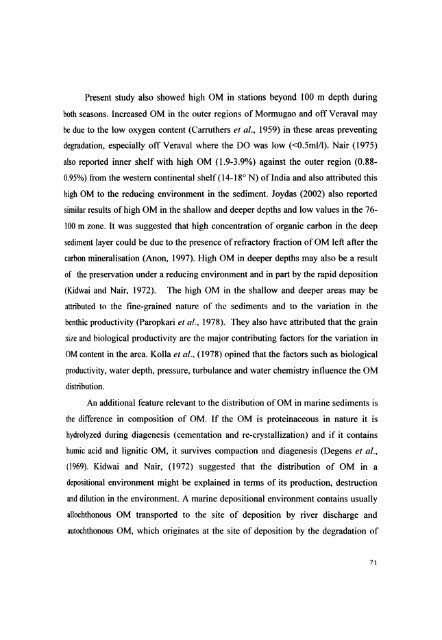L - Cochin University of Science and Technology
L - Cochin University of Science and Technology
L - Cochin University of Science and Technology
Create successful ePaper yourself
Turn your PDF publications into a flip-book with our unique Google optimized e-Paper software.
Present study also showed high OM in stations beyond 100 m depth during<br />
both seasons. Increased OM in the outer regions <strong>of</strong> Monnugao <strong>and</strong> <strong>of</strong>f Veraval may<br />
be due to the low oxygen content (Carruthers et al., 1959) in these areas preventing<br />
degradation, especially <strong>of</strong>f Veraval where the DO was low «0.5ml/l). Nair (1975)<br />
also reported inner shelf with high OM (1.9-3.9%) against the outer region (0.88-<br />
0.95%) from the western continental shelf(14-18° N) <strong>of</strong> India <strong>and</strong> also attributed this<br />
high OM to the reducing environment in the sediment. Joydas (2002) also reported<br />
similar results <strong>of</strong> high OM in the shallow <strong>and</strong> deeper depths <strong>and</strong> low values in the 76-<br />
100 m zone. It was suggested that high concentration <strong>of</strong> organic carbon in the deep<br />
sediment layer could be due to the presence <strong>of</strong> refractory fraction <strong>of</strong> OM left after the<br />
carbon mineralisation (Anon, 1997). High OM in deeper depths may also be a result<br />
<strong>of</strong> the preservation under a reducing environment <strong>and</strong> in part by the rapid deposition<br />
(Kidwai <strong>and</strong> Nair, 1972). The high OM in the shallow <strong>and</strong> deeper areas may be<br />
attributed to the fine-grained nature <strong>of</strong> the sediments <strong>and</strong> to the variation in the<br />
benthic productivity (Paropkari et al., 1978). They also have attributed that the grain<br />
size <strong>and</strong> biological productivity are the major contributing factors for the variation in<br />
OM content in the area. Kolla et al .. (1978) opined that the factors such as biological<br />
productivity, water depth, pressure, turbulance <strong>and</strong> water chemistry influence the OM<br />
distribution.<br />
An additional feature relevant to the distribution <strong>of</strong> OM in marine sediments is<br />
the difference in composition <strong>of</strong> OM. If the OM is proteinaceous in nature it is<br />
hydroJyzed during diagenesis (cementation <strong>and</strong> re-crystallization) <strong>and</strong> if it contains<br />
humic acid <strong>and</strong> lignitic OM, it survives compaction <strong>and</strong> diagenesis (Degens et al.,<br />
(1969). Kidwai <strong>and</strong> Nair, (1972) suggested that the distribution <strong>of</strong> OM in a<br />
depositional environment might be explained in tenns <strong>of</strong> its production, destruction<br />
<strong>and</strong> dilution in the environment. A marine depositional environment contains usually<br />
allochthonous OM transported to the site <strong>of</strong> deposition by river discharge <strong>and</strong><br />
autochthonous OM, which originates at the site <strong>of</strong> deposition by the degradation <strong>of</strong><br />
71

















